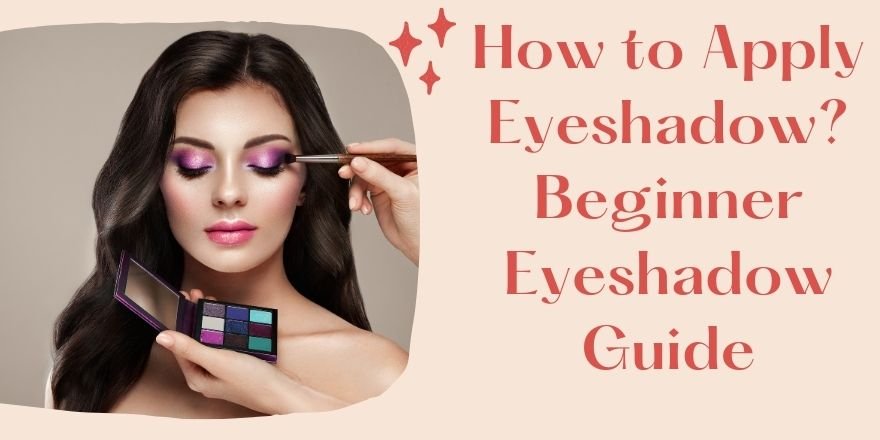Ever find yourself in a place where you need clarification about how to do eyeshadow for the perfect eye makeup game? The noticeable balance between a natural appearance and a dramatic nighttime effect can be challenging. Worry no more if you feel like something needs to be added to your eyeshadow application. You are not alone here if you are curious about applying eyeshadow perfectly.
If you've ever found yourself looking at stunning eyeshadow looks and wondering how to achieve them, you've come to the right place. In this beauty guide, "How to Apply Eyeshadow?" I am going to reveal the secrets of applying eyeshadow like a pro, whether you're a beginner or someone looking to upgrade your existing skills. From choosing the perfect eyeshadow palette to mastering essential techniques, get ready to unlock the key to enhance the eye game in the world of makeup application. Let's dive straight into the eyeshadow tutorial for beginners which helps you to enter the beautiful world of eyeshadow application to improve your inner makeup artist and welcome yourself into the world of eye makeup artistry!
What Is Eye Shadow?
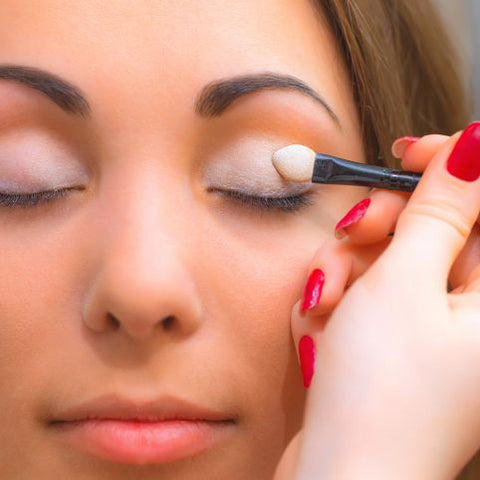
Eyeshadow is a popular cosmetic product specifically designed for application on the eyelids and around the eyes. Eye shadow comes in various shades, textures, and finishes, allowing for endless possibilities in creating attractive eye makeup looks.
Why Is Eyeshadow Essential in Eye Makeup?
Eyeshadow is an essential component of eye makeup for several reasons. Eye shadow makeup helps to add depth and dimension to the eyes, making them appear more captivating and attractive. With different shades and finishes, eyeshadow can enhance the eye's natural shape and create various effects, such as making it appear larger or more lifted.
Applying eyeshadow also allows for endless creative possibilities by complementing and enhancing the eye color, making it pop and stand out. Whether you have blue, green, brown, or any other eye color, selecting the right eyeshadow shades can focus attention on the natural beauty of your eyes. Whether you want a soft, everyday look or a glamorous, smoky eye, eyeshadow is a versatile component that can transform and uplift your eye makeup game.
When to Apply Eyeshadow?
Knowing when to apply eyeshadow is crucial for achieving the desired eye makeup look. The best time to apply eyeshadow is after you have completed your skincare routine and applied any eye primer for the base. Applying eyeshadow after the skincare routine ensures a smooth surface for the eyeshadow placement and helps it stick better and last longer.
Whether you're getting ready for a daytime event or a night out, applying eyeshadow early in your makeup routine allows you to blend and build the colors seamlessly. By starting with eyeshadow, you can also avoid any fallout or smudging on your foundation or concealer. Remember, the key is to take your time, blend well, and build the intensity gradually.
How to Pick the Right Eyeshadow?
Picking the right eyeshadow is essential for achieving a stunning eye makeup look as a Beginner. To choose the perfect eyeshadow, consider factors such as your eye color, skin tone, and the desired effect you want to create. To enhance your eye color, select shades that are complementary or contrasting. For example, if you have blue eyes, warm tones like copper and bronze can make them pop. When it comes to skin tone, consider whether you have warm or cool undertones. Considering undertones according to skin tone helps to enhance your natural features and make your eyes pop. If you have warm undertones, opt for earthy tones like browns and gold, while cool undertones can be enhanced with shades like purples and silvers.

If you are a beginner, choose matte shadows, which are more forgiving of mistakes and easy to wear on any skin type. Lastly, consider the effect you want to achieve, whether a natural, everyday look or a bold, dramatic statement. By considering these factors, you can confidently choose the right eye shadow shades that will enhance your eyes and complement your overall everyday look.
Finding the Right Tools for Eyeshadow
When it comes to finding the right tools to blend eyeshadow, you'll need a few essential items to achieve a flawless eye makeup look. First, you must invest in a good quality eyeshadow palette that offers a range of shades to suit your preferences and style. Look for a versatile palette with a mix of matte and shimmer finishes. While makeup sponges, particularly wedge-shaped ones, are commonly used for applying foundation or concealer, they are not the typical tool for applying eyeshadow. Eyeshadow is often applied using makeup brushes specifically designed for this purpose.
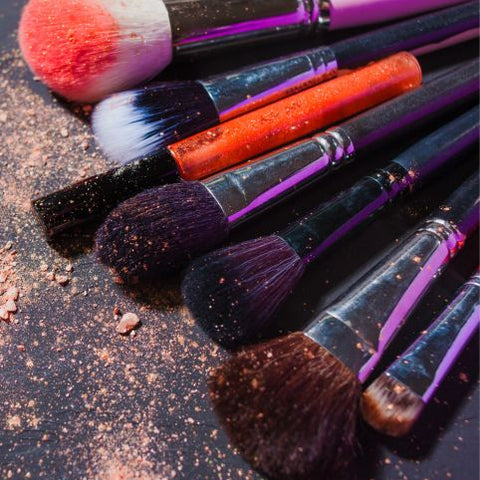
Additionally, high-quality eye shadow brushes are essential for precise application and blending. Look for brushes specifically designed for eyeshadow, such as a flat shader brush, a fluffy blending brush, and a small detail brush for more detailed work. By having a well-chosen eyeshadow palette and the right selection of brushes, you'll be well-equipped to create stunning eye looks.
How to Apply Eyeshadow Correctly?
Applying eyeshadow is a fun and creative process that can upgrade your eye makeup game. Applying eye makeup correctly requires attention to detail and a good understanding of techniques. Once you have familiarized yourself with the importance of eyeshadow in makeup application, you will feel more comfortable and confident during the process.
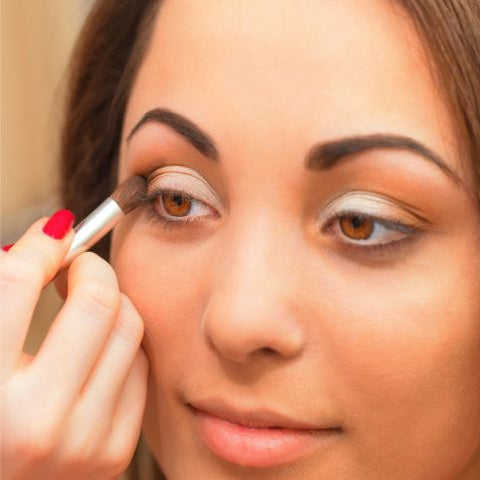
Finding the right tools and selecting the appropriate eyeshadow are crucial factors that contribute to the desired results of your eyeshadow looks. With all this knowledge in mind, you are now prepared for a smooth and successful application process. There are a few essential things to consider while applying eyeshadow. Here's a step-by-step guide on how to wear eyeshadow:
Prepare Eyelids:
Preparing eyelids is the first eyeshadow step for precise application of eyeshadow. Start with clean eyelids and apply an eyeshadow primer or a concealer on your eyelids. This will create a smooth base for the eyeshadow and help the application last longer.
Determining Eye Shape:
Determining your eye shape is crucial for applying eyeshadow perfectly. Identifying whether you have hooded, almond, round, monolid, or deep-set eyes will help you understand the best techniques and placement of eyeshadow to enhance your natural features and achieve a flawless look.
Choose Eyeshadow Colors:
Choose the colors you want to use for your simple eyeshadow looks to achieve the desired results. It's helpful to have a light shade for the base, a medium shade for the crease, and a darker shade for the outer corner or to create depth and dimensions.
Apply the Base Color:
Take a flat eyeshadow brush and apply the lightest shade all over your eyelid, from the lash line to the brow bone. A base color will create a base and help the other colors blend smoothly.
Define the Crease:
Use a fluffy blending brush to apply the medium shade to the crease of your eyelid. Use back-and-forth windshield wiper motions to blend the color and create a soft transition. Build up the color gradually until you achieve your desired intensity.
Add Depth:
Take a smaller eyeshadow brush and apply the darker shade to the outer corner of your eyelid, forming a "V" shape. Blend the color well to avoid any harsh lines.
Blend the Colors:
Use a clean blending brush to blend all the colors, ensuring a seamless transition from light to dark. Blending the color is crucial for a professional-looking eyeshadow application.
Highlight the Brow Bone:
Apply a shimmery or matte light shade just beneath your eyebrow and blend it gently to highlight the brow bone.
Line the Eyes:
If you want to add more definition, apply eyeliner along your upper lash line or tightline your upper waterline. This step is optional and depends on the look you're going for.
If you are looking for a perfect eyeliner, try Black Diamond Eyeliner from StansOut Beauty for a smudge-proof formula that ensures your eyeliner stays all day and night.
Finish With Mascara and Lashes:
Finish off your eyeshadow look by applying mascara to your lashes. When you apply mascara, it helps to frame and accentuate the eyeshadow colors. You can also add false lashes for extra drama if desired.
Following the above-mentioned steps, you can confidently present your art of eyeshadow application. Remember, practice makes perfect, so keep going even if your first attempts are not flawless. Experiment with different techniques, colors, and finishes to find the eyeshadow style that suits you best.
[Recommended to Read: Prom Makeup Looks]
How Can I Make My Eyeshadow Last Longer?
To make your eyeshadow last longer and prevent it from creasing or fading throughout the day, follow these tips:
Start with an eyeshadow primer. Applying primer creates a smooth, even base for the eyeshadow. It also adds grip and boosts its longevity. Look for primers specifically formulated to increase eyeshadow wear time and prevent creasing in the crease. Apply it from the lash line to the brow bone before your eyeshadow.
Secondly, set your eyeshadow with a translucent powder or setting spray once you've blended out all the shades. A light dusting of powder helps soak up any excess oil and locks down the pigments. Finish with an all-over mist of makeup setting spray to mesh the powders and create a long-lasting, vibrant eye makeup look that won't budge. These eyeshadow setting techniques will maximize its wear and keep your lids looking fresh.
[Recommended to Read: How to Make Your Makeup Last All Day]
Eyeshadow Shades to Avoid According to Skin Tone
Choosing the correct eyeshadow shades is important for having a natural-looking flawless eye look. While choosing eyeshadow shades that compliment your skin tone, there are certain colors that you might want to avoid. For fair skin tones, it's best to keep away from extremely cool-toned shades like stark whites or pastel blues. Those cool-toned shades with fair skin tones can make you look washed out.
Those with medium skin tones should avoid orangey-red eyeshadows, as they can clash with warm undertones. Deep skin tones may want to skip shades like chalky light pinks or yellows, as they can appear dull and unflattering against richer complexions. The key is selecting eyeshadow colors that complement your skin's undertones for a naturally radiant makeup look.
Common Mistakes While Applying Eyeshadow
While applying eyeshadow, common makeup mistakes are made, knowingly or unknowingly. Those mistakes can result in a bad appearance and mess up your whole appearance. So, it is important to be aware of such mistakes while applying eyeshadow that can affect the overall look of your eye makeup. Here are some common mistakes to avoid:
Starting with unprepared eyes:
Starting with unprepared eyes refers to applying eyeshadow without cleansing or priming the eyelids first. This can lead to issues like oily eyelids causing creasing, uneven texture affecting the application, and lack of color payoff.
How to correct this: Always start your eyeshadow application by cleansing your eyelids and using eye primer to achieve a smooth base surface for the application and to increase longevity.
Using the wrong brushes:
Different types of brushes are available for applying eyeshadow. The type of brush you use can greatly affect the application and blending of eyeshadow. Using the right brush size or shape can make it easier to achieve the desired look. Invest in a few good-quality brushes designed for eyeshadow application.
How to correct this: Always use brushes made to target specific work. Such as:
- Flat shader brush: for packing eyeshadow onto the eyelid.
- Blending brush: for blending and diffusing eyeshadow colors.
- Crease brush: for adding depth to the crease and outer V area.
- Pencil brush: for precise application in small areas like the outer corner or lower lash line. The pencil brush's thin bristles and pointed tips help in easy and comfortable application
-
Smudge brush: for smudging and blending eyeliner or eyeshadow along the lash line.
And many more.
Applying too much product:
It's easier to gradually build up the intensity of eyeshadow rather than applying too much product at once. Applying too much eyeshadow can make it harder to blend and can lead to a messy, overdone look.
How to correct this: Start with a light layer and gradually add more as needed. Make sure you slightly rub the eyeshadow palette and tap to get rid of excess powder before the eyeshadow application.
Neglecting to blend:
Blending is key to achieving a seamless and professional-looking eyeshadow application. Harsh lines or unblended edges can make your eyeshadow appear patchy and uneven.
How to correct this: Use a clean blending brush to soften any harsh lines and blend the colors together for a smooth transition. This helps in easy application and smooth finish.
Ignoring your eye shape:
Different eye shapes require different eyeshadow techniques to enhance their natural beauty. For example, if you have hooded eyes, you may need to apply eyeshadow higher on the lid to create the illusion of depth.
How to correct this: Take some time to understand your eye shape and research techniques that work best for you.
Using too many colors:
While it can be tempting to use a wide range of eyeshadow colors, using too many shades can result in a muddled and messy look. Stick to a maximum of three complementary colors to create a cohesive and balanced eye makeup look.
How to correct this: Select a few key colors and focus on blending and transitioning them seamlessly. Doing this helps you to achieve a polished and well-balanced eye makeup look that enhances your natural features.
Neglecting to clean up fallout:
Eyeshadow fallout refers to the excess product that falls onto the under-eye area during application. It's crucial to clean up this fallout as it may mess up the whole makeup application.
How to correct this: Clean up the fallout by using a clean brush, makeup remover washcloth, or a makeup removing rounds to avoid a messy and smudged appearance.
By avoiding these common mistakes, you can enhance your eyeshadow application and achieve a polished and professional look.
[Recommended to Read: Different Eyeliner Styles to Try for Enhancing Your Eye Beauty ]
How to Apply Eyeshadow with Fingers?
Along with the brushes, some prefer to apply eyeshadow with their fingers. So, here is the summary on how to do eyeshadow application with fingers:
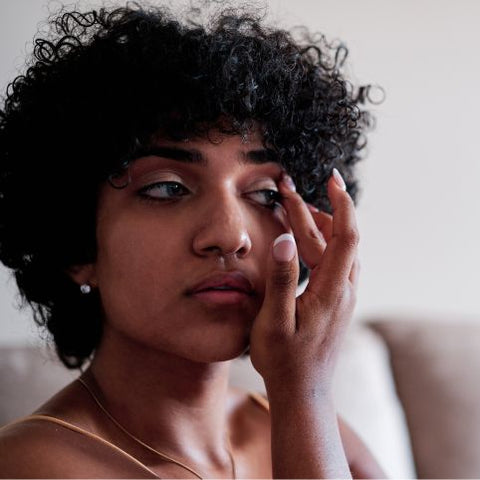
Step 1:Prep your eyelids.
Step 2: Choose your eyeshadow.
Step 3: Apply an eyeshadow primer.
Step 4: Pick up the product with your finger.
Step 5: Pat or press the eyeshadow onto your eyelid.
Step 6: Blend and spread the color.
Step 7: Layer and build up the intensity if desired.
Step 8: Blend the edges for a seamless look.
Step 9: Repeat for other colors if using multiple shades.
Step 10: Clean up any mistakes and set with setting powder or setting spray if desired.
[Recommended to Read: Best Way to Remove Makeup]
Final Thoughts On Applying Eyeshadow
Figuring out how to apply eyeshadow helps you achieve the desired eye look and pushes you towards mastering the world of eye games. Applying eyeshadow can be easy if you know how to do it properly. You can achieve a precise and polished look by following a few simple steps. Start by preparing your eyelids and determining your eye shape. Choose eyeshadow colors and apply the base color to define the crease. Add depth and blend the colors, highlighting the brow bone. Remember to apply eyeliner for more definition and finish the process with mascara and false lashes if desired.
Making yourself familiar with the right tools boosts confidence and makes the application more comfortable. Understanding the benefits of eyeshadow and choosing the correct shades helps achieve a natural appearance. Avoid common mistakes to improve your application. Remember, with practice and patience, you'll be comfortable and confident in applying eyeshadow like a pro in no time.
Like this article? Share it with your friends by clicking the icons below!


